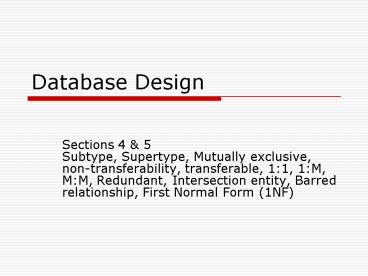Database Design - PowerPoint PPT Presentation
1 / 35
Title:
Database Design
Description:
QUIZ. BONUS. QUESTIONS. STUDENT. included in. included. taken by. Global Fast Food Employees ... Relationship transferability ... Redundant relationship ... – PowerPoint PPT presentation
Number of Views:75
Avg rating:3.0/5.0
Title: Database Design
1
Database Design
- Sections 4 5Subtype, Supertype, Mutually
exclusive, non-transferability, transferable,
11, 1M, MM, Redundant, Intersection entity,
Barred relationship, First Normal Form (1NF)
2
DJs on Demand Partial ERD
3
Reserved Words
- A reserved work is one that has a specific
meaning and function in the computer system,
language, or database. - Examples
- NULL
- DATE
- DISTINCT
4
Video Store example 4.1.7
- Identify business rules
- Construct ERD
- Class activity
5
Video Store Matrix
6
Video ERD
featured in
7
Use Source Documents
- Source document assist in identifying entities,
attributes, and relationships
8
Global Fast Food
- Identify entities
9
Possible solution
STAFF id first name last name date of
birth salary
handle
handled by
ORDER number date time
FOOD ITEM number description price
list
listed on
10
Subtype Supertype
- Supertype (entity) can be subdivided into
Subtypes - Example
JOB manager clerk sales support
11
Attributes
- Supertype can have attributes at supertype level
- Attributes at supertype level are for all
subtypes - Subtypes can have own attributes for only that
attribute
12
Example
13
Global Fast Food Employees
- STAFF is an entity and supertype
- What are the attributes of STAFF?
- What subtypes exist in STAFF?
- Are there any attributes in any of the subtypes?
14
Example 4.3.9
- AUTOMOBILE subtypes are not mutually exclusive
- AUTOMOBILE possible solution
- BUILDING subtypes have problem of not being
exhaustive, should be minimum of 2 types
15
Business Rules
- Recognize if Business rule is implemented by the
data model or by programming - Example
- Only an employee with a title of manager can
manage other employees - The event planner must contact the customer
before the DJ can be assigned - Business rules can changed as society changes or
business leaders feel change needed
16
Business rule types
- Structural
- Must be entered at time of initial data entry
- Example When ORDER entered a staff id must be
entered - Does not require code written to enforce
- Procedural
- Work flow related
- Programmed validation is procedural constraint
- Generally need to write code
- Example Commission can not be 25 of salary
17
Each entity has
- Name
- Optionality
- Cardinality
- Transferability
18
Relationship transferability
- Rules established for the purpose such as safety,
efficiency, or increased profit - Example Airline tickets
- can be transferable or non-transferable?
- Non-transferable means also not updatable
- symbol used to denote non-transferable
- blood type is non-transferable
19
Non-transferable relationship
- Orders are non-transferable
- Resolution would be to cancel order and create
new order
20
Example 5.1.6 1
- Each town may be the birthplace of many people.
Each person must be born in one and only one
town.
21
Relationship types
- One to One (11)
- One to Many (1M)
- Many to Many (MM)
22
One to One relationship
- Usually few of these relationships
- Often mandatory at one side
- If mandatory at both ends be aware, it might be a
error. Possible should be only one entity not
two
23
One to Many
- Most common type are mandatory on one side and
optional on the other - Mandatory at both ends models entities that
cannot exist without each other
24
One to Many example
25
Many to Many
- Often common in initial version of ERD
- Later stage of design converted to other type
26
Redundant relationship
- Redundant relationship is one that can be derived
from another relationship in the model
27
Many to Many Relationship Resolution
- All MM relationships must be changed to a set of
1M and M1 relationship - Insert a transition entity between
- Occurs when you go from conceptual model to
design model
28
Example MM with Intersection Entity
29
Resolving MM with Intersection
- Create an intersection entity
- If you cant find a good intersection entity
create one by concatenate two entities together
30
Example
31
Normalization
- To make sure you dont store the same data twice
in the model - Also, that you store the data in the correct
place - We will cover the first 3 normal forms.
32
First Normal Form (1NF)
- First Normal Form requires that there be no
multivalued attributes and no repeating groups. - To check for 1NF, validate that each attribute
has a single value for each instance of the
entity. - In other words One value per Attribute.
33
Example 1NF
- This has multiple values for the classroom.
SCHOOL BUILDING code name address classroom
34
Example 1NF
- Telephone is a multvalued attribute that could be
an Entity. Ie. Home, work, mobile, fax etc. - Not all Employees have multiple phones, so there
would eliminate multiple NULL values.
EMPLOYEE id name address . . º telephone º
salary
35
Review 1NF examples
- Look at the 4 examples on 5.4.4































